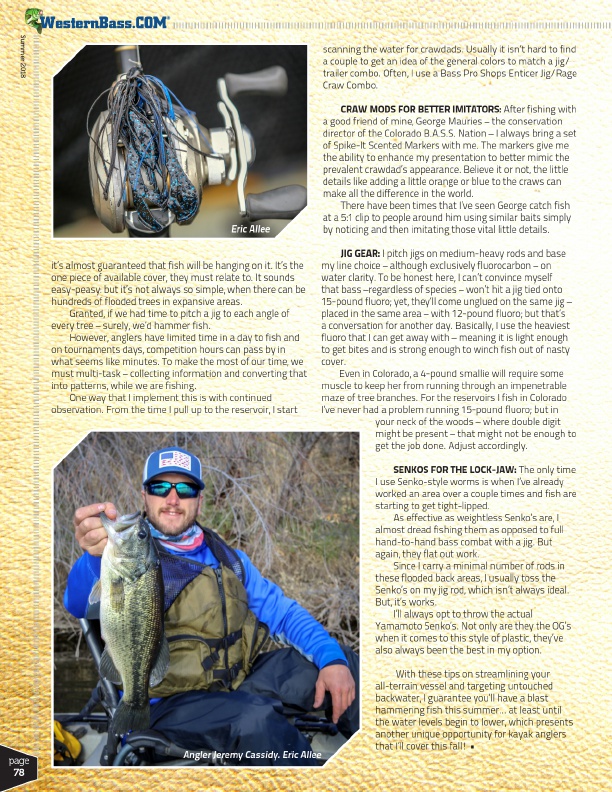
®
Summer 2018
page
78
scanning the water for crawdads. Usually it isn’t hard to find a couple to get an idea of the general colors to match a jig/ trailer combo. Often, I use a Bass Pro Shops Enticer Jig/Rage Craw Combo.
Eric Allee
CRAW MODS FOR BETTER IMITATORS: After fishing with a good friend of mine, George Mauries – the conservation director of the Colorado B.A.S.S. Nation – I always bring a set of Spike-It Scented Markers with me. The markers give me the ability to enhance my presentation to better mimic the prevalent crawdad’s appearance. Believe it or not, the little details like adding a little orange or blue to the craws can make all the difference in the world.
There have been times that I’ve seen George catch fish at a 5:1 clip to people around him using similar baits simply by noticing and then imitating those vital little details.
it’s almost guaranteed that fish will be hanging on it. It’s the one piece of available cover, they must relate to. It sounds easy-peasy: but it’s not always so simple, when there can be hundreds of flooded trees in expansive areas.
Granted, if we had time to pitch a jig to each angle of every tree – surely, we’d hammer fish.
However, anglers have limited time in a day to fish and on tournaments days, competition hours can pass by in what seems like minutes. To make the most of our time, we must multi-task – collecting information and converting that into patterns, while we are fishing.
One way that I implement this is with continued observation. From the time I pull up to the reservoir, I start
JIG GEAR: I pitch jigs on medium-heavy rods and base my line choice – although exclusively fluorocarbon – on water clarity. To be honest here, I can’t convince myself that bass –regardless of species – won’t hit a jig tied onto 15-pound fluoro; yet, they’ll come unglued on the same jig – placed in the same area – with 12-pound fluoro; but that’s a conversation for another day. Basically, I use the heaviest fluoro that I can get away with – meaning it is light enough to get bites and is strong enough to winch fish out of nasty cover.
Even in Colorado, a 4-pound smallie will require some muscle to keep her from running through an impenetrable maze of tree branches. For the reservoirs I fish in Colorado I’ve never had a problem running 15-pound fluoro; but in
your neck of the woods – where double digit
might be present – that might not be enough to
get the job done. Adjust accordingly.
SENKOS FOR THE LOCK-JAW: The only time I use Senko-style worms is when I’ve already worked an area over a couple times and fish are starting to get tight-lipped.
As effective as weightless Senko’s are, I almost dread fishing them as opposed to full hand-to-hand bass combat with a jig. But again, they flat out work.
Since I carry a minimal number of rods in these flooded back areas, I usually toss the Senko’s on my jig rod, which isn’t always ideal. But, it’s works.
I’ll always opt to throw the actual Yamamoto Senko’s. Not only are they the OG’s when it comes to this style of plastic, they’ve also always been the best in my option.
Angler Jeremy Cassidy. Eric Allee
With these tips on streamlining your all-terrain vessel and targeting untouched backwater, I guarantee you’ll have a blast hammering fish this summer… at least until the water levels begin to lower, which presents another unique opportunity for kayak anglers that I’ll cover this fall! •